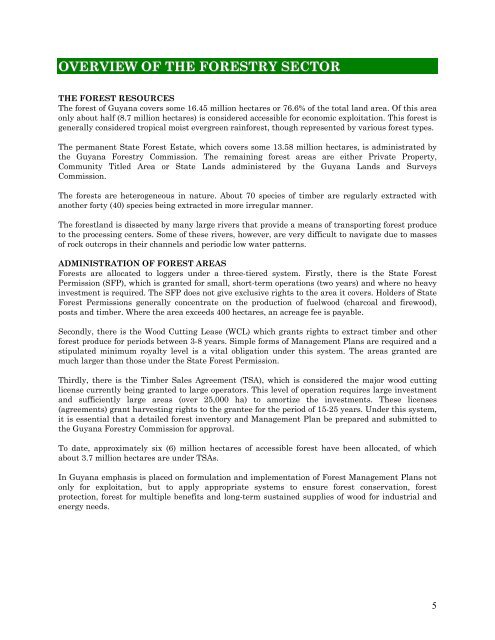21 Species Booklet 2004.pdf - Guyana Forestry Commission
21 Species Booklet 2004.pdf - Guyana Forestry Commission
21 Species Booklet 2004.pdf - Guyana Forestry Commission
Create successful ePaper yourself
Turn your PDF publications into a flip-book with our unique Google optimized e-Paper software.
OVERVIEW OF THE FORESTRY SECTOR<br />
THE FOREST RESOURCES<br />
The forest of <strong>Guyana</strong> covers some 16.45 million hectares or 76.6% of the total land area. Of this area<br />
only about half (8.7 million hectares) is considered accessible for economic exploitation. This forest is<br />
generally considered tropical moist evergreen rainforest, though represented by various forest types.<br />
The permanent State Forest Estate, which covers some 13.58 million hectares, is administrated by<br />
the <strong>Guyana</strong> <strong>Forestry</strong> <strong>Commission</strong>. The remaining forest areas are either Private Property,<br />
Community Titled Area or State Lands administered by the <strong>Guyana</strong> Lands and Surveys<br />
<strong>Commission</strong>.<br />
The forests are heterogeneous in nature. About 70 species of timber are regularly extracted with<br />
another forty (40) species being extracted in more irregular manner.<br />
The forestland is dissected by many large rivers that provide a means of transporting forest produce<br />
to the processing centers. Some of these rivers, however, are very difficult to navigate due to masses<br />
of rock outcrops in their channels and periodic low water patterns.<br />
ADMINISTRATION OF FOREST AREAS<br />
Forests are allocated to loggers under a three-tiered system. Firstly, there is the State Forest<br />
Permission (SFP), which is granted for small, short-term operations (two years) and where no heavy<br />
investment is required. The SFP does not give exclusive rights to the area it covers. Holders of State<br />
Forest Permissions generally concentrate on the production of fuelwood (charcoal and firewood),<br />
posts and timber. Where the area exceeds 400 hectares, an acreage fee is payable.<br />
Secondly, there is the Wood Cutting Lease (WCL) which grants rights to extract timber and other<br />
forest produce for periods between 3-8 years. Simple forms of Management Plans are required and a<br />
stipulated minimum royalty level is a vital obligation under this system. The areas granted are<br />
much larger than those under the State Forest Permission.<br />
Thirdly, there is the Timber Sales Agreement (TSA), which is considered the major wood cutting<br />
license currently being granted to large operators. This level of operation requires large investment<br />
and sufficiently large areas (over 25,000 ha) to amortize the investments. These licenses<br />
(agreements) grant harvesting rights to the grantee for the period of 15-25 years. Under this system,<br />
it is essential that a detailed forest inventory and Management Plan be prepared and submitted to<br />
the <strong>Guyana</strong> <strong>Forestry</strong> <strong>Commission</strong> for approval.<br />
To date, approximately six (6) million hectares of accessible forest have been allocated, of which<br />
about 3.7 million hectares are under TSAs.<br />
In <strong>Guyana</strong> emphasis is placed on formulation and implementation of Forest Management Plans not<br />
only for exploitation, but to apply appropriate systems to ensure forest conservation, forest<br />
protection, forest for multiple benefits and long-term sustained supplies of wood for industrial and<br />
energy needs.<br />
5


